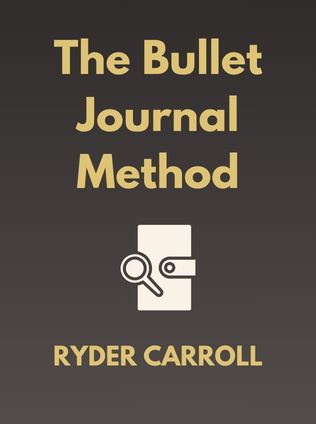
The Bullet Journal Method
Track the Past, Order the Present, Design the Future
By Ryder Carroll
Published 10/2018
About the Author
Ryder Carroll, a digital product designer based in New York City, is the visionary behind the Bullet Journal Method. His journey to creating this unique organizational system began as a personal quest for order in a life filled with distractions and responsibilities. Carroll’s need to streamline his thoughts and tasks led to the development of the Bullet Journal, which eventually evolved into a comprehensive system for planning, reflecting, and managing life’s complexities. What started as a simple tool to help him focus became a global movement, inspiring people around the world to live more intentional and organized lives. Carroll’s work is rooted in the belief that productivity isn’t about doing more but about focusing on what truly matters.
Main Idea
The Bullet Journal Method is more than just a productivity tool; it’s a framework for living a more intentional life. At its core, the method is designed to help you track the past, organize the present, and plan for the future. Carroll’s approach is minimalist, flexible, and adaptable, allowing users to tailor the system to their individual needs and goals. By engaging with this method, you’re not just keeping track of tasks—you’re actively shaping your life, reflecting on your values, and making conscious decisions that align with your true priorities.
Table of Contents
- Why You Should Start Bullet Journaling
- Components of the Bullet Journal Method
- How to Get Started
- The Role of Reflection
- Customizing Your Journal
- Putting Productivity Into Practice
- Living Your Best Life
Why You Should Start Bullet Journaling
In today’s fast-paced world, where technology constantly bombards us with information, it’s easy to feel overwhelmed and distracted. Despite the myriad tools designed to help us stay productive, many people find themselves struggling to keep up with their responsibilities. According to Carroll, the rise of technology has paradoxically led to a decline in productivity because our attention is spread too thin. This is where the Bullet Journal Method comes in. It offers a simple yet powerful solution to the chaos by helping you focus on what truly matters. The Bullet Journal isn’t just about writing down tasks; it’s about being intentional with your time and energy, allowing you to gain clarity on your goals and priorities.
Bullet Journaling as a Solution
The Bullet Journal Method helps you tackle three major challenges: getting organized, living in the present moment, and finding clarity on what’s important to you. By consolidating all your tasks, thoughts, and plans into one notebook, you can declutter your mind and create a sense of order. Unlike digital tools, which can be overwhelming with their many features, the simplicity of a notebook allows for complete flexibility. You can tailor the Bullet Journal to suit your needs, making it as detailed or as minimalistic as you like. Moreover, the act of writing by hand encourages you to slow down and engage more deeply with your thoughts, helping you to live more mindfully and make intentional choices about how you spend your time.
"The Bullet Journal is designed to help you track the past, organize the present, and plan for the future." – Ryder Carroll
Components of the Bullet Journal Method
The Bullet Journal Method consists of several key components, each serving a specific purpose in helping you stay organized and focused. These components include the Index, Future Planner, Monthly Overview, Daily Record, and the Bullet System. Together, they create a comprehensive framework for managing your life. Let’s explore each component in detail:
Sign up for FREE and get access to 1,400+ books summaries.
You May Also Like
The Subtle Art of Not Giving a F*ck
A Counterintuitive Approach to Living a Good Life
By Mark MansonRich Dad Poor Dad
What the Rich Teach Their Kids About Money - That the Poor and Middle Class Do Not!
By Robert T. KiyosakiHow To Win Friends and Influence People
The All-Time Classic Manual Of People Skills
By Dale CarnegieQuiet: The Power of Introverts
The Power of Introverts in a World That Can't Stop Talking
By Susan Cain



















